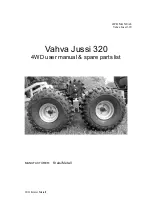
5
guination
before
tourniquet
application
may
be
done
without
the
use
of
an
elastic
bandage
by
elevating
the
limb
for
3
to
5
minutes.
In
case
of
failure,
the
tourniquet
cuff
must
be
fully
deflated
and
the
limb
exsanguinated
again
before
reinflation.
Reinflation
over
blood
‐
filled
vasculature
may
lead
to
intravascular
thrombosis.
Tourniquet
users
must
be
familiar
with
the
inflation
/
deflation
sequence
when
using
two
tourniquet
cuffs
and
two
PTS
ii
units
together
for
IVRA
(Bier
Block
anesthesia),
so
that
the
wrong
tourniquet
will
not
be
released
accidentally.
Test
for
hemoglobin
type
and
level
before
using
a
tourniquet
on
patients
with
sickle
‐
cell
anemia.
When
the
tourniquet
is
used
for
these
patients,
the
limb
should
be
carefully
exsanguinated
and
the
PO2
and
pH
should
be
closely
monitored.
Select
the
proper
cuff
size
to
allow
for
the
overlap
recommended
by
the
cuff
manufacturer.
Too
much
or
too
little
overlap
may
cause
cuff
rolling
and
telescoping,
unexpected
release
of
the
cuff
from
the
limb,
inability
to
maintain
a
bloodless
field
at
normal
pressures,
and/or
undesired
pressure
distribution
on
the
limb.
The
skin
under
the
tourniquet
cuff
must
be
protected
from
mechanical
injury
by
smooth,
wrinkle
‐
free
application
of
the
cuff.
If
the
tourniquet
cuff
is
applied
over
any
material
that
may
shed
loose
fibers
(such
as
Webril)
the
fibers
may
become
embedded
in
the
contact
closures
and
reduce
their
effectiveness.
Follow
the
cuff
manufacturer’s
recommendations
for
limb
protection
material
under
the
cuff.
In
general,
a
limb
protection
sleeve
designed
specifically
for
the
cuff
provides
the
best
protection.
If
skin
preparations
are
used
preoperatively,
they
should
not
be
allowed
to
flow
nor
collect
under
the
cuff
where
they
may
cause
chemical
burns.
Whenever
the
tourniquet
cuff
pressure
is
released,
the
wound
should
be
protected
from
blood
surging
back
by
applying
pressure
dressings
and,
if
necessary,
elevating
the
limb.
Transient
pain
upon
tourniquet
pressure
release
can
be
lessened
by
elevation
of
the
limb.
If
full
color
does
not
return
within
3
to
4
minutes
after
release,
the
limb
should
be
placed
in
a
position
slightly
below
body
level.
The
deflated
cuff
and
any
underlying
limb
protection
material
should
be
completely
removed
as
soon
as
tourniquet
pressure
is
released.
After
the
cuff
has
been
fully
deflated
and
removed
from
the
patient,
the
unit
can
be
set
to
STANDBY.
Even
the
slightest
impedance
of
venous
return
may
lead
to
congestion
and
pooling
of
blood
in
the
operative
field.
Whenever
IVRA
(Bier
Block
anesthesia)
is
used,
it
is
recommended
that
the
tourniquet
remain
inflated
for
at
least
20
minutes
from
the
time
of
injection.
1.5
ADVERSE
EFFECTS
A
dull
aching
pain
(tourniquet
pain)
may
develop
throughout
the
limb
following
use.
Stiffness,
weakness,
reactive
hyperemia,
&
skin
discolouration
may
also
occur
to
some
degree
in
all
patients
after
tourniquet
use.
Pathophysiologic
changes
due
to
pressure,
hypoxia,
hypercarbia,
and
acidosis
of
the
tissues
occur
and
become
significant
after
about
1
1/2
hours
of
tourniquet
use.
Symptoms
of
tourniquet
paralysis
are
motor
paralysis
and
loss
of
sense
of
touch,
pressure,
and
proprioceptive
responses.
Intraoperative
bleeding
may
be
caused
by:
1.
The
slight
impeding
effect
exerted
by
an
unpressurized
cuff
(and
its
limb
protection
material
or
padding,
if
used),
which
prevents
venous
return
at
the
beginning
of
the
operation,
2.
Blood
remaining
in
the
limb
because
of
insufficient
exsanguination,
3.
Inadequate
tourniquet
pressure,
or
slow
inflation
and
deflation,
all
if
which
allow
arterial
blood
to
enter
while
preventing
venous
return,
4.
Blood
entering
through
the
nutrient
vessels
of
the
long
bones,
such
as
the
femur
or
humerus.







































